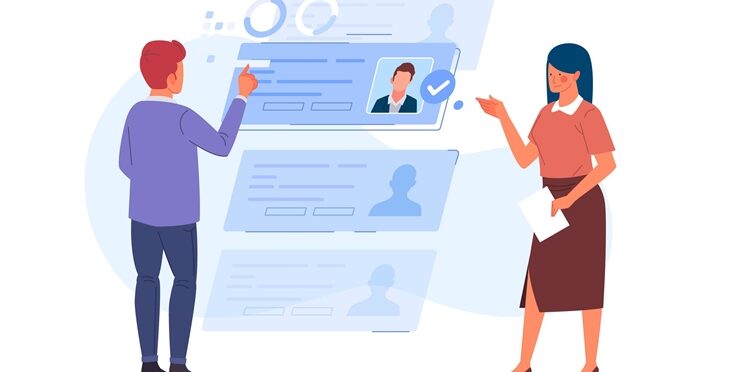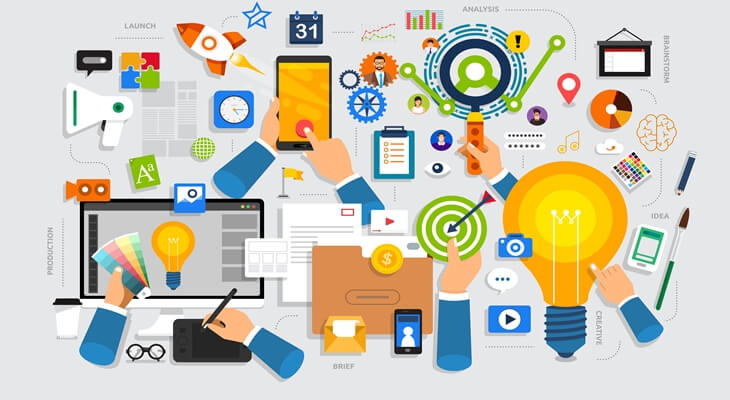AI And ML In Human Resources have several consequences for HR and employment. We'll look at how these tools will affect the future of human resources management in this article. We'll also discuss the currently available technology and some of the most popular AI/ML applications in HR.
Artificial Intelligence In HR
Artificial intelligence allows software and computer systems to make decisions in the same way humans do. Machine learning algorithms analyze data. To refine their predictions and improve outcomes, they recognize underlying trends and patterns.
Since HR relies on the human factor, one can wonder how ML human resources look. The idea is that artificial intelligence (AI) enables managers to make strategic decisions. These data-driven decisions also improve the experience of current and prospective employees. It also allows them to gain a better understanding of their target market. They can also build human resource procedures that are motivated by results.
Machine Learning In HR
Transactional workforce data is used in machine learning. It predicts everything from employee satisfaction to weariness and turnover risk. Optimizing scheduling and workloads increase the employee experience. It also boosts productivity and retention.
The most common application of machine learning in HR is to automate administrative activities. Automation allows managers to spend more time with their staff while promoting a productive work environment.
Artificial intelligence-powered chatbots make it easier to communicate with staff. Moreover, the experience has a human-like quality to it. It gives employees the opportunity to address specific problems. Tasks like administrating benefits packages and interviews can also eat up an HR professional’s valuable time. Whereas, a machine learning model, on the other hand, can automate them.
What Are The Effects/Benefits Of AI And ML In Human Resources?
SOURCING
Due to tight labor markets, today's businesses must market their open positions. When AI is used to improve sourcing, an organization's ability to identify the right people in a timely manner improves. It can also assist with:
Find The Most Qualified Individuals
Find employees who best fit the job based on their abilities and experience. In addition to searching for important terms, ML systems look for synonyms in resumes.
Recommend Applicants For Positions
Candidates are encouraged to apply for available opportunities after receiving recommendations. These candidates can also be found through organic search or a tailored campaign. Before posting a job, AI can alert the right people with the correct skill sets about it.
Candidate Performance Can Be Predicted
AI-based candidate matching calculates an applicant's metrics using HR data. It also calculates the probability of accepting a job offer, project performance outcomes, and expected tenure.
INTERVIEWING AND SCREENING
The employment of digital assistants is a big advantage of AI during the interview stage. Candidates will also have a more engaging candidate experience with digital assistants, which can include:
Assist Candidates In Becoming More Self-Reliant
From rescheduling/canceling to sending reminders, they have complete control over the interviewing process. They can also share notes and make resource recommendations for review.
Providing Assistance To Recruiting Managers
AI reminds them of upcoming interviews and provides details on candidates. Primary data of employees in similar tasks, AI can also help eliminate subjectivity. It can also ask hiring supervisors specific questions. This emphasizes the candidate's skill set and gives additional context to the job's nature. AI can also be compared to similar professions at other companies.
SELECTING AND OFFERING
In human resources, AI and machine learning assist recruiters and managers in making better hiring decisions. It gives them the ability to:
Compared To High Achievers
Candidates Should Compare job prospects to other high achievers in similar roles in the firm using benchmark data and AI.
Make Personalised Offers
Analyze the data points about the market and rival salaries. It also offers a systematic and nuanced look at how roles should be divided. AI can also improve the efficiency of hiring. It can do so by matching a specific offer to a person's career and employment history. AI predicts whether an applicant will accept or decline an offer.
Candidate Conduct Can Be Predicted
Predict a candidate's likelihood of accepting, performing, and staying in the job.
ONBOARDING
Onboarding is important. It sets the tone for the duration of the employee's employment. AI aids in:
Streamline The Administrative Process
AI automates the distribution and receipt of important documents, company policies, and login credentials. Artificial intelligence (AI) can also read documents, gather electronic signatures, and eliminate the need for HR to follow up.
24/7 Onboarding
By helping the new hire through all of the needed onboarding stages, digital assistants improve the process. They also propose the next measures for them to take to advance in their position.
Reduce The Time It Takes To Become Productive
AI-driven digital assistants can recommend job-related learning. These are based on the experiences of successful employees in similar positions. It includes books and journal articles that are pertinent to the topic.
CAREER DEVELOPMENT
The evolution of how job searchers and employees achieve professional growth is one of the primary subjects of discussion at work. Organizations must take a deliberate approach to career development to retain personnel. Employees also expect learning and professional development opportunities to help them advance in their professions. AI provides the following benefits:
Personalized Suggestions
Employees can receive curated professional development advice. These suggestions change with the business and help you reach your full potential. Moreover, managerial guidance is supplemented by tailored content. It also demonstrates to employees that their employers take interest in their professional development.
Personalized Career Planning
AI gathers data on each employee's professional development. It then sends it to you in a customized manner. Each person can chart their career path to fill in the gaps in their talents. The most excellent method to encourage learning is to provide people with clarity and the tools they need to make career changes.
SUCCESSION MANAGEMENT
Determine Flight Risk
To plan its results, flight risk prediction uses a variety of attributes and actions. Employee sentiment, mentors, tenure, prospective career paths, income history, and so on are among the attributes. All of this accounts when calculating an attrition rate. It offers leaders crucial indicators and clues on how to retain their most valuable personnel.
Identify Capable Successors
Data models can assist in analyzing employee behavior and determining which individuals are ready to take on new responsibilities. This is based on cultural fit, leadership ability, and previous success or accomplishments.
COMPENSATION
Compensation is a labor market concern, as workers seek more remuneration for their worth. Employees are confident in their ability to obtain work elsewhere in this tight labor market. They can also request pay hikes to improve their living conditions. Employers, likewise, face a dilemma in this atmosphere. The problem is to guarantee that the appropriate compensation is provided for the right positions. This is vital to avoid overpaying or underpaying. AI aids in:
Provide Market Knowledge
AI provides a strategic and fine-tuned picture of how roles should be divided. It accomplishes this by examining a plethora of salary data points about the local market and competitor information.
Boost The Effectiveness Of Recruiting
By calculating the probabilities of a job acceptance by connecting a specific offer with individual career and employment histories.
LEARNING
As a result of these fundamental shifts, reskilling has become the new recruiting trend. As a result, firms are now looking to learn and develop to fill skills gaps in various areas. AI aids in:
Make Learning More Individualised
Learning is relevant, adaptive, and meaningful, it has a greater impact. AI collects data about a worker's learning habits, skill interests, work style, etc.
This aids in making appropriate course recommendations to the employee. These courses help employees be more productive and competent at work.
Encourage Collaboration
Employees from several departments are frequently required to learn from and with one another. They can use AI to assist them in finding each other. Collaboration promotes cross-functional learning, streamlines business procedures, and boosts team effectiveness. This method of learning is ideal for today's work environment.
Optimize Learning Administration
Administrators' workloads can be reduced by AI adjusting curricula based on role, geography, and line of business. They can also record information about learner participation, interactions, and outcomes. Leadership can better manage and report on how learning improves the organization with more optimization and insight.
Conclusion
The most recent developments in AI and ML In Human Resources are making their way into the mainstream. This has resulted in a significant shift in how people connect with technology and their teams around the world.
At work, the relationship between humans and robots is being reshaped. There is no one-size-fits-all solution to change management. Instead, businesses should collaborate with their human resources department. To match the shifting expectations of their teams around the world, they must personalize their approach to using AI at work.





